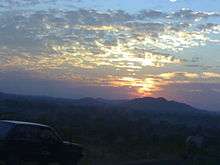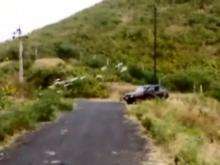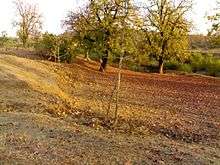Devgadh Baria
| Devgadh Baria Devgadhbaria, Baria | |
|---|---|
| city | |
 Devgadh Baria  Devgadh Baria Location in Gujarat, India | |
| Coordinates: 22°42′08″N 73°54′54″E / 22.702207°N 73.915029°ECoordinates: 22°42′08″N 73°54′54″E / 22.702207°N 73.915029°E | |
| Country |
|
| State | Gujarat |
| District | Dahod |
| Population (2001) | |
| • Total | 19,201 |
| Languages | |
| • Official | Gujarati, Hindi |
| Time zone | IST (UTC+5:30) |
| Vehicle registration | GJ |
| Website |
gujaratindia |
Devgadh Baria is a municipality in Dahod district in the state of Gujarat, India. It is a small town nestled in the foothills on the eastern border of Gujarat State. It is 44 kilometers from Godhra in the west, 54 kilometeres from Dahod in the east and 14 kilometeres south of Ahmedabad-Indore highway (National Highway 59). It was established in 1782. The Baria State was ruled by Chauhan kings until its merger with the Union of India. The last ruler of Devgadh Baria was married to a daughter of Gayatri Devi of Jaipur. Rajasthan, India.
History of Baria
Devgadh Baria is located on the bank of Panam River; a town built very articulately in princely style. It is part of Dahod district (formerly Panchmahal) in the state of Gujarat.
This town was established in the year 1782. Two sons of King Vatai Rawal escaped from this region when the famous King of Gujarat, Mohammad Beghda, tried to conquer Pavagadh. Older brother Prithiraj’s son Udaisinh established the town of Chhota Udaipur, whereas the younger brother Dungerpursinh established the famous town of Devagadh Baria. The family of Dungersinh ruled the Baria State for the twelve generations.
The state of Baria was always safe due to the unique geographical location. King of Baria never gave any monitory compensation to Moslems or Maratha rulers. Internal state affairs were performed independently, without any outside help. Baria State was divided into Sagtala, Rajgadh, Haveli, Dhanpur, Limkheda and Randhikpur. These regions were known as Mahals. Administrators and Thanedars were appointed for the smooth administration of each Mahals.
In 1864, after the death of King Dungersinh, a coronation ceremony was held to declare his grandson Mansing as the ruler king. At the time coronation he was only nine years old and hence the administration of the state was entrusted to an agency. A superintendent was appointed by this agency during 1865 to 1876. During this time, each town of the Baria State was surveyed and a limit was established. King Mansinh took over the administration back from the agency on 6 November 1876.
King Mansinh was reformer and had a modern outlook. He started some important educational institutions like: A school with English education, Kumar Shala – a school for the boys, Kanya Shala – a school for the girls, and a Chhatralaya – a dormitory. He also established the police force, and justice and revenue departments. In 1892 a proposal was made to start a railroad system from Godhara to Ratlam via Devgadh Baria, but because Baria wanted to remain independent, the plans were changed and permission was granted to start railway system from Piplod to Limkheda. Late on, Baria-Piplod narrow gauge railway was built by the state.
King Mansinh died in 1908, leaving behind him, two sons and a daughter – Ranjitsinhji, Naharsinhji and Surajkuvarba. His marble statue in the Baria circle bazaar is a pride monument of Baria. Man Sarovar, a huge lake, in honor of this great king, reminds us all of his fame.
At the coronation ceremony in the year 1908, Ranjitsinhji was installed as king. Highly educated and a person with brilliant career, he had joined the Imperial Cadet Core and was awarded the title of “Knight Commander of India”. Because of this prestigious title, he was popularly known as Sir Ranjitsinhji.
During his rule, some very important public institutions were established, some of them are a jigh school, a veterinary hospital, a gymkhana, a tower, asked a library. Free education was offered in the state to all the school going students, to bring cultural awareness in the society. It was a golden period for the sports in Baria during Sir Ranjitsinhji’s rule. Rudisinhji and Hirasinhaji of royal family were very much interested in various sports. During this period inviting teams from outside cities held sports like polo, badminton, tennis and table tennis were being played in Baria and competitions.
In 1943 the small state of Ratanmal, which in 1891 had only 468 inhabitants ( mostly Bhils), was merged with the State of Baria within the attachement scheme plan of integrating small princely states with larger ones.[1]
After the death of Sir Ranjitsinhji, his grandson, Jaydipsinhji (son of Youvraj Subhagsinhji) was established as a King, at the coronation ceremony in the year 1948. A few years after India gained independence from British rule, all the small kingdoms and kings were abolished and their authorities were taken away. In this transformation process, Baria was merged into Bombay State. Jaydipsinhji was no longer a king but during his entire life span in Baria, he had already established himself as a king in everybody’s hearts . During his rule Sir Madhavsinh Lalji Chuahn was the superintendent of police of Baria State. He was devoted to his duty and rewarded for his duty.
During the period of 1961-1987, he was elected as a Member of Legislative Assembly in Gujarat, and was also a Member of Parliament in Delhi, from 1961 to 1987.
Shri Jaydipsinhji was a Rajyogi. He had donated most of his personal assets to various institutions for the common good of the people of Baria and surrounding areas. His own Rajmahal (King’s residential Palace) was donated to Gujarat Agricultural Institution. He established AdivasiResearch and Training institution, for uplifting of these poor people. Old Rajmahal was also dedicated to the Baria Higher Education Society. He started Yuvraj Subhagsinhji Arts College for the higher college education. An assports complex was started in the big open space of Sir Ranjitsinhji Gymkhana, for the enhancement of various sports events. Shri Jaydipsinhji was honorable country member of the Olympics.
More information about the history of the town may be obtained from a website created by North American immigrants from Baria.[2]
As of 2001 India census,[3] Devgadh Baria has a population of 19,201. Males constitute 51% of the population and females 49%. Devgadh Baria has an average literacy rate of 61%, higher than the national average of 59.5%: male literacy is 70% and, female literacy is 53%. In Devgadh Baria, 15% of the population is under 6 years of age.
The ruler, Subhak Singh Chauhan, chad two sons and one daughter. The older son was Jaideep Singh Chauhan and the younger son was Pradeep Singh Chauhan. and the daughter was Samyukta Singh, who was married in Rajnangaon. Jaideep Singh Chauhan had a daughter, Urvashi Devi, who like her father, was also active in politics for 25 years. She has a son, Tushar Singh, born on 19 April 1973, who is also active in politics like his mother. Tushar singh is a Member of the Legislative Assembly in India.he is married to ambika kumari and has two sons, Jaideep Singh Chauhan's brother Pradeep Singh Chauhan was married to princess Tika Rajya Lakshmi Singh from Nepal and had two sons, Jitendra Singh Chauhan and Udayendra Singh Chauhan. Jitendra Singh Chauhan was born on 7 January 1962 while Udayendra Singh Chauhan was born on 3 November 1963 and died on 16 June 2003 in Baria.
The last ruler of Baria H H Maharawal Jaideep Singhji married Prem Kumari, Princess of Jaipur, only daughter of Sawai Man Singh II of Jaipur (last ruler of Jaipur) and his 1st Maharani Marudhar Kunwar (Princess of Jodhpur) in 1948. This wedding is considered one of the most expensive and grand royal weddings in Independent India and was recorded in the Guinness Book of World Records. She was known as an outsider giving the name Baria. Prem Kumari then said every women from this town will be known as an outside aka known as "bharwali". He later then married another princess.
On 15 February 2015 the royal family consisting of Princess Urvashi Devi, her son Tushar Singh, his wife Ambika Kumari and their two sons Arunoday Singh and Nirbhay Singh moved back into the original residence of the royal family known as "Rajmahal". After getting the palace back from the government in 2006 and spending nine years behind the renovations it has been restored to its original glory.[4] A very big "vastu-pujan" ceremony was held on the occasion attended by approximately 10000 people who represented every town and village of the erstwhile state of Devgadh Baria. Due to popular demand and according to the last wishes of Maharaja Jaideep Singhji; Tushar Singh was crowned as His Highness Maharaja Saheb of Devgadh Baria by his uncle Jitendra Singhji and elders of the rajput community and neighboring princely states along with representatives of all communities and village heads.[5] Thus instating Tushar Singhji "Maharaja Tushar Singh of Devgadh Baria" as the head of the royal family, his wife Ambika Kumari as "Maharani Ambika Kumari of Devgadh Baria" and his elder son Arunoday Singh as "Yuvraj Arunoday Singh of Devgadh Baria".
Baria the Beautiful
Baria has quite a few picturesqe places - for example Sunset point at Chougania valley south of the town, through which meanders the Panam river.

The valley provides a breath taking sight of egrets flying home from the river and Tidki reservoir in twilight.

Less than 2 kilometers east of Chougania is the relatively unspoilt Khos valley with any number of hiking trails away from vehicular noise and emissions. That is where clusters of Mahua trees transform the arid landscape when they shed their leaves in peak summer. The intensity of the colour needs to be seen to be believed. Nature’s spread lasts but a few weeks, before the farmers burn the leaves to facilitate gathering of Mahua flowers for making inter alia the heady mahua wine.



Ratan Mahal Sanctuary
It is a mixed deciduous forest, located in Devgadh baria, Dahod District of Gujarat at Madhya Pradesh (MP) border. Though it occupies Gujarat and MP, maximum area covered in Gujarat. Sanctury mainly consists of Sloth Bears and known as Ratanmahal Sloth Bear Sanctuary. Ratanmahal Sanctuary is near by River Panama (a major river of gujrat central), which makes more ecological balance in Forest including water conservation.![]()
References
- ↑ Nath, Y V S; Bhils of Ratanmal: An Analysis of the Social Structure of a Western Indian Community; Baroda 1960 (M. A. Thesis)
- ↑ Baria.Org - Baria Mitra Mandal - Home Page
- ↑ "Census of India 2001: Data from the 2001 Census, including cities, villages and towns (Provisional)". Census Commission of India. Archived from the original on 2004-06-16. Retrieved 2008-11-01.
- ↑ http://timesofindia.indiatimes.com/city/vadodara/Paris-of-Panchmahals-royal-palace-renovated/articleshow/46241540.cms
- ↑ http://article.wn.com/view/2015/02/17/After_65_years_Baria_royals_anoint_heir/
External links
![]() Media related to Devgadh Baria at Wikimedia Commons
Media related to Devgadh Baria at Wikimedia Commons